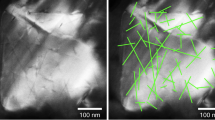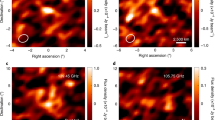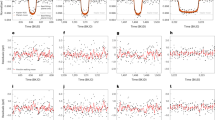Abstract
THE Ulysses spacecraft detected streams of sub-micrometre-sized dust particles as it approached Jupiter in 19921,2. Although interplanetary space was known to contain dust, the presence of discrete streams was completely unexpected. The directions from which the dust grains struck the spacecraft strongly suggested that the source lay somewhere within the Jupiter system. Three origins were proposed, the comet Shoemaker–Levy 9 (ref. 3), Jupiter's gossamer ring4, and the volcanoes on Io5, but there was no definitive evidence for or against any of the options. Here we report the detection by the Galileo spacecraft of even more intense dust streams—including three intense dust storms of month-long duration, with impact rates up to 10 times higher than those observed by Ulysses. Our analysis of the data confirms that the dust streams originate near Jupiter; we are able to rule out a cometary origin, but cannot yet determine conclusively whether the dust comes from Io or the ring.
This is a preview of subscription content, access via your institution
Access options
Subscribe to this journal
Receive 51 print issues and online access
$199.00 per year
only $3.90 per issue
Buy this article
- Purchase on Springer Link
- Instant access to full article PDF
Prices may be subject to local taxes which are calculated during checkout
Similar content being viewed by others
References
Grün, E. et al. Nature 362, 428–430 (1993).
Baguhl, M., Grün, E., Linkert, G., Linkert, D. & Siddique, N. Planet. Space Sci. 41, 1085–1098 (1993).
Grün, E. et al. Geophys. Res. Lett. 21, 1035–1038 (1994).
Hamilton, D. P. & Burns, J. A. Nature 364, 695–699 (1993).
Horányi, M., Morfill, G. E. & Grün, E. Nature 363, 144–146 (1993); J. geophys. Res. 98, 21245–21251 (1993).
Grün, E. et al. Space Sci. Rev. 60, 317–340 (1992).
Grün, E. et al. Astr. Astrophys. Suppl. 92, 411–423 (1992).
Grün, E. et al. Planet. Space Sci. 43, 941–951 (1995).
Zook, H. A. et al. in Physics, Chemistry, and Dynamics of Interplanetary Dust (eds Gustafson, B. A. S. & Hanner, M. S.) (Conf. Ser., Astr. Soc. Pacific, Provo, UT, in the press).
Kivelson, M. G., Khurana, K. K., Means, J. D., Russell, C. T. & Snare, R. C. Space Sci. Rev. 60, 357–384 (1992).
Johnson, T. V., Morfill, G. E. & Grün, E. Geophys. Res. Lett. 7, 305–308 (1980).
Srama, R., Grün, E. and the Cassini Dust Science Team in Physics, Chemistry, and Dynamics of Interplanetary Dust (eds Gustafson, B. A. S. & Manner, M. S.) (Conf. Ser., Astr. Soc. Pacific, Provo, UT, in the press).
Collins, S. A. J. geophys. Res. 86, 8621–8626 (1981).
Baguhl, M. et al. Space Sci. Rev. 72, 471–476 (1995).
Author information
Authors and Affiliations
Rights and permissions
About this article
Cite this article
Grün, E., Baguhl, M., Hamilton, D. et al. Constraints from Galileo observations on the origin of jovian dust streams. Nature 381, 395–398 (1996). https://doi.org/10.1038/381395a0
Received:
Accepted:
Issue Date:
DOI: https://doi.org/10.1038/381395a0
This article is cited by
-
Interplanetary Dust, Meteoroids, Meteors and Meteorites
Space Science Reviews (2019)
-
Dust in the Jupiter system outside the rings
Astrodynamics (2019)
-
Circumplanetary Dust Populations
Space Science Reviews (2019)
-
Dust Emission by Active Moons
Space Science Reviews (2018)
-
The cosmic dust analyser onboard cassini: ten years of discoveries
CEAS Space Journal (2011)
Comments
By submitting a comment you agree to abide by our Terms and Community Guidelines. If you find something abusive or that does not comply with our terms or guidelines please flag it as inappropriate.



